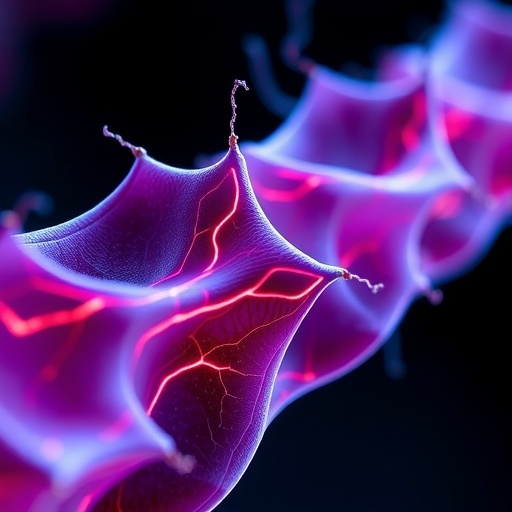A newly unveiled molecular mechanism sheds light on how human skin senses and responds to physical tension, orchestrating its own expansion and growth. Researchers at Johns Hopkins Medicine have identified the protein Piezo1 as a critical mechanosensor that detects stretching forces in the skin, triggering a cascade of metabolic and immune responses necessary for skin proliferation. This groundbreaking discovery, published recently in Nature Communications, reveals Piezo1 as a pivotal regulator of tension-driven skin growth and opens avenues for novel, noninvasive interventions aimed at enhancing skin regeneration — a crucial advance especially relevant for patients requiring skin grafts following burns, trauma, or surgical reconstruction.
Skin, as the body’s largest and most dynamic organ, adapts continuously to physical stresses, including moderate stretching that occurs during growth phases such as childhood development and pregnancy. While it has been well-established that excessive mechanical stress leads to skin tearing and damage, the molecular underpinnings that translate moderate tension into constructive skin expansion have eluded scientists for decades. The new study by the Johns Hopkins team now unveils key molecular events coordinated by Piezo1, positioning it as the linchpin between mechanical stimuli and biological growth signals.
Piezo1 is known as a mechanotransducer protein, capable of converting physical forces experienced by cells into intracellular chemical signals. Prior research had detected elevated levels of Piezo1 in skin tissues, hinting at a functional role, but its precise contribution to skin physiology remained elusive. In an elegant series of experiments leveraging advanced spatial transcriptomics, the researchers mapped gene expression patterns spatially across skin samples subjected to mechanical expansion in mouse models. These analyses revealed that stretching the skin induces widespread molecular changes involving pathways tied to angiogenesis, stress response, and immune cell activation — all strongly associated with Piezo1 expression.
To delineate Piezo1’s functional role, the team employed pharmacological activation and genetic deletion strategies. When mice were treated with Yoda1, a chemical agonist that activates Piezo1, the skin’s inflammatory and metabolic pathways related to tension were amplified markedly. Such activation translated into pronounced physiological effects: increases of around 130% in skin surface area and epidermal thickness were observed, along with elevated skin weight, compared to untreated controls. These results underscore not only the sensitivity but also the potency of Piezo1 signaling in stimulating skin growth in response to tension.
Conversely, mice engineered to lack Piezo1 specifically in their skin — effectively “knockout” animals — showed deficient adaptation to mechanical stretch. In comparison to normal mice, these knockout animals experienced measurable reductions in skin surface area, weight, and thickness under tension conditions. This diminution validates that without Piezo1’s mechanosensory input, the skin’s intrinsic growth program is severely impaired. Such findings highlight how indispensable Piezo1 is for enabling skin to respond and adapt appropriately to mechanical cues.
Among the critical pathways intersecting with Piezo1-mediated signaling is the TGF-beta pathway, recognized for regulating immune functions and cellular proliferation. The coordinated upregulation of TGF-beta signaling and immune cell activity suggests that Piezo1 functions as more than a mere mechanical sensor. It acts as a master integrator that balances inflammation, metabolism, and growth factor signaling to execute complex skin expansion programs. These multifaceted roles situate Piezo1 at the nexus of biomechanical and biochemical communication within the skin microenvironment.
Understanding the molecular basis of tension-induced skin growth has far-reaching implications for regenerative medicine. Current clinical approaches for skin regeneration, including mechanical expansion using silicone devices, though effective, are limited by technical challenges such as infection risk, discomfort, and long treatment durations. The revelation that Piezo1 activation alone can induce robust skin growth provides a promising molecular target for developing pharmacologic agents or gene therapy approaches to enhance skin repair and regeneration noninvasively.
Importantly, this research moves beyond correlative studies by demonstrating causation through carefully controlled mechanistic experimentation. The combined use of spatial transcriptomics and functional assays not only confirmed the spatial and temporal dynamics of gene activation during skin expansion but also pinpointed Piezo1 as the critical mediator orchestrating these responses. Such comprehensive methodology sets a new standard for mechanobiology research in dermatology.
While the current findings derive from murine models, the researchers emphasize the translational potential of their work. Future studies aim to investigate how Piezo1-mediated pathways operate in human skin, potentially enabling clinicians to leverage this mechanism in therapeutic settings. The prospect of harnessing Piezo1 to stimulate endogenous skin growth may revolutionize treatment paradigms for burn victims, patients with chronic wounds, and individuals with congenital skin defects.
Moreover, the research contributes to the broader understanding of mechanotransduction in tissue biology — a rapidly evolving field exploring how mechanical forces shape cellular behavior and organ function. The novel insights into Piezo1’s role may inspire investigations in other organ systems where mechanical forces regulate development and pathology, extending the impact of these findings across medical disciplines.
Scientists caution, however, that precise modulation of Piezo1 activity will be necessary to avoid excessive or aberrant tissue growth, which could have deleterious effects. Achieving balanced activation calls for fine-tuned therapeutic strategies, informed by deeper exploration of downstream signaling networks and cellular interactions influenced by Piezo1.
In sum, this pioneering study provides compelling evidence that the protein Piezo1 is not merely present in skin but fundamentally commands the molecular orchestra necessary for the epidermis and dermis to expand in response to mechanical tension. The prospect of therapeutically manipulating Piezo1 represents a transformative opportunity in skin biology and regenerative medicine, promising a future where skin repair is faster, safer, and less invasive than ever before.
Subject of Research: Mechanotransduction and skin growth mediated by Piezo1 protein.
Article Title: (Not explicitly provided in the content)
News Publication Date: July 25, 2025
Web References: https://www.nature.com/articles/s41467-025-62270-3
References: Not explicitly detailed beyond publication and funding acknowledgments.
Image Credits: Nature Communications, Yingchao Xue, Luis A. Garza
Keywords: Dermatology, Translational medicine, Translational research
Tags: childhood skin developmenthuman skin response to tensionimmune response in skin growthmechanical stress and skin healthmetabolic responses in skinmolecular mechanisms in tissue expansionnoninvasive skin treatmentsPIEZO1 protein functionskin graft advancementsskin mechanotransductionskin regeneration mechanismstissue growth regulation





